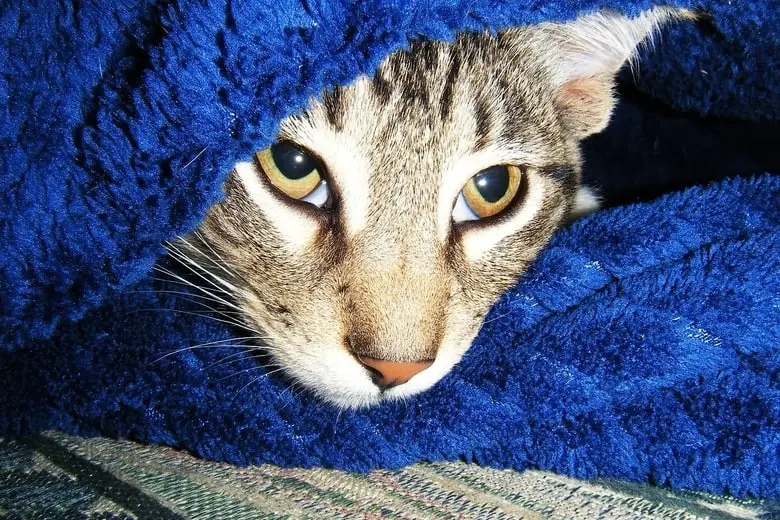While many of us think of a cat’s tail as one of its defining features, you may be surprised to learn that not all cats have tails. Upon seeing a tailless cat, most people’s immediate reaction is pity, having assumed that the appendage was lost in a tragic accident.
Although (unfortunately) this does occur, there are a number of breeds that are naturally born without tails. In fact, the tailless gene is a hereditary trait among domesticated cats and is the defining feature of many breeds. Here we’ll go over 8 cats with no tail and describe their characteristics.
8 Cats With No Tail
Notably, many cats on this list are not truly tailless. They will usually possess a “stump” or “nub” at the base of their spine, which is itself a malformed and truncated tail. Albeit technically present, a short tail may as well not be there, as it does not serve a practical function.
1. Kurilian Bobtail
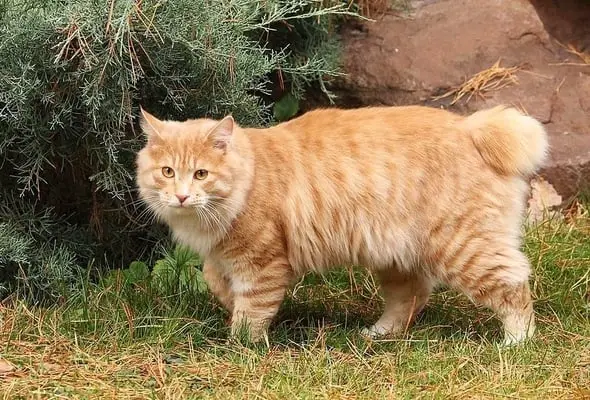
Average Lifespan: 15-20 years
Average Size: 11-15 pounds
Coat: medium-long
A stocky cat, the Kurilian Bobtail was originally developed and bred on the Kuril Islands in Russia. Records show it to have been around for at least 200 years, and it is thought to be a landrace breed.
An excellent fisher, this breed is known to enjoy playing and interacting with running and still water. With its long coat, it is well-suited to life outdoors and is independently minded.
While its tail is short and dysfunctional, it is not truly nonexistent. Registries and breeders have described the Kurilian Bobtail’s tail as “kinked” and malformed, typically drooping forward onto its back.
2. Pixie-Bob Cat
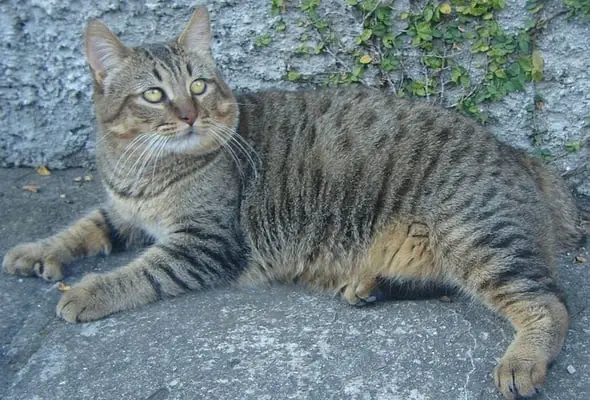
Average Lifespan: 11-15 years
Average Size: 10-15 pounds
Coat: short
The Pixie-Bob Cat has a fascinating origin story. Two short-tailed cats were discovered by Carol Brewer in 1985 in Washington, USA, and that she used to found the breed. While starving, one of these individuals still weighed in at nearly 17 pounds. Owing to its large size, it was thought to have been sired by a Bobcat.
Although there is no conclusive evidence of its wild heritage, the breed does resemble the American Bobcat, both in its coat pattern and signature bobbed tail. This is the only breed of cats with no tail on our list with possible ties to actual bobcats.
Muscular and with a solid frame, the Pixie-Bob is a strong and athletic breed well suited to both indoor and outdoor living. While capable of independence, the breed is also known to make an affectionate and loving companion.
3. American Bobtail
Average Lifespan: 13-15 years
Average Size: 7-16 pounds
Coat: short or long
As the name suggests, the American Bobtail was originally bred and developed in the United States in the 1960s, and was said to have been produced by crossing domestic cats with bobcats.
However, unlike the Pixie-Bob, there is concrete scientific evidence suggesting the tailless gene in the American Bobtails is not inherited from bobcats, but is naturally occurring among domesticated cat populations, and is similar in nature to the Manx’s short-tailed gene.
A stocky and robust breed, the American Bobtail takes unusually long to mature, usually reaching adulthood between 2-4 years old. It is an uncommon breed and may be difficult to come by.
4. Manx Cat

Average Lifespan: 9-13 years
Average Size: 8-12 pounds
Coat: short (occasionally long)
The Manx Cat was originally developed on the Isle of Man in Great Britain and was used to help control rodent populations on farms and in houses. A skilled hunter, the Manx Cat is stocky and muscular, possessing a compact and athletic body. While often short-haired, there are known to be long-haired individuals of the breed.
Unlike most of the cats on our list of cats with no tail, the tails of Manx Cats are variable in length, ranging from entirely nonexistent to kinked and middling in length.
5. Cymric Cat
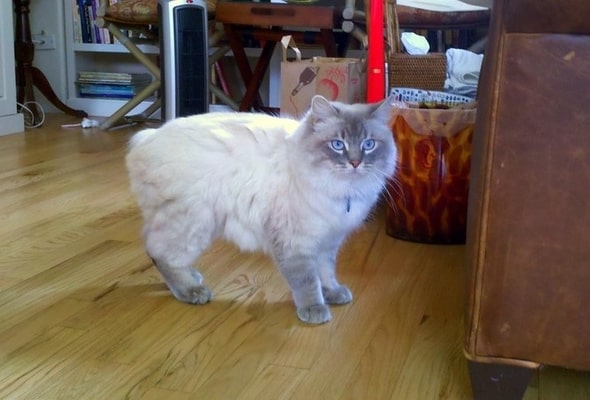
Average Lifespan: 9-13 years
Average Size: 8-12 pounds
Coat: long
According to some cat registries, the Cymric Cat is not listed as a distinct breed, and is simply the long-haired variant of the Manx Cat. As a variant of the Manx Cat, the Cymric Cat also possesses the same stocky body and frame as its short-haired brother, and is considered an excellent hunter and outdoor cat.
In fact, Cymric kittens are often born to regular short-haired Manx Cats. Similarly, the short-haired Manx can appear in Cymric litters.
6. Japanese Bobtail Cat
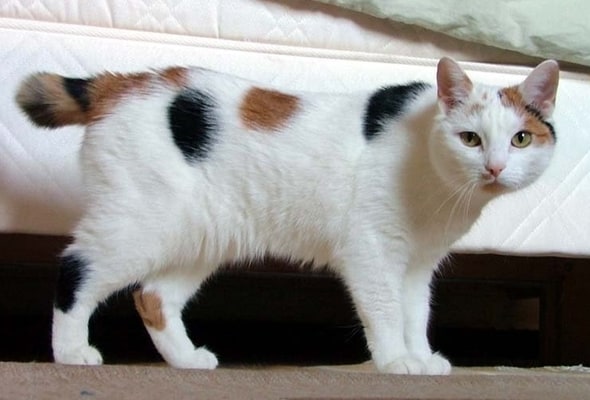
Average Lifespan: 9-15 years
Average Size: 6-10 pounds
Coat: short
As the name implies, the Japanese Bobtail Cat originates from Japan, where it was thought to have appeared over 1,000 years ago.
An ancient cat with unclear origins, the breed has appeared prominently in Japanese art and folklore, recognizable from its almost nonexistent tail, which many have compared to the tails of rabbits.
The Japanese Bobtail Cat is an affectionate breed. Great for families with children, this cat is known to make chirping vocalizations to its owners.
7. Highlander Cat
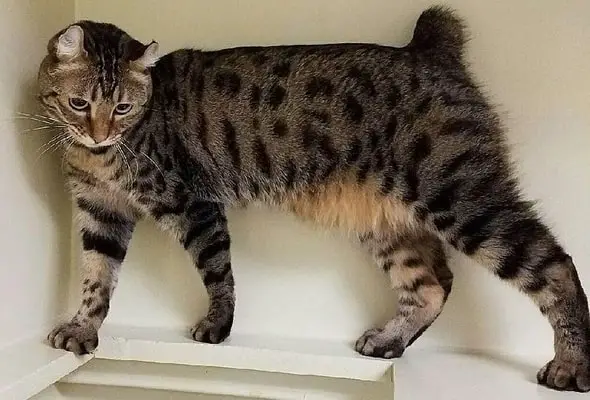
Average Lifespan: 7-15 years
Average Size: 15-20 pounds
Coat: short
The most recently developed of the cats with no tails on our list, breeding of the Highlander Cat first began in 2004 and was formally recognized as an independent breed in 2015.
Created by crossing Desert Lynx and Jungle Curl breeds, the Highlander Cat was developed for its wild and unique look, which has drawn comparisons with wild cat species such as the Lynx and Bobcat.
One of its more notable features, aside from its shortened tail, is the breed’s curved and upturned ears, a trait inherited from its Jungle Curl parentage.
8. Mekong Bobtail
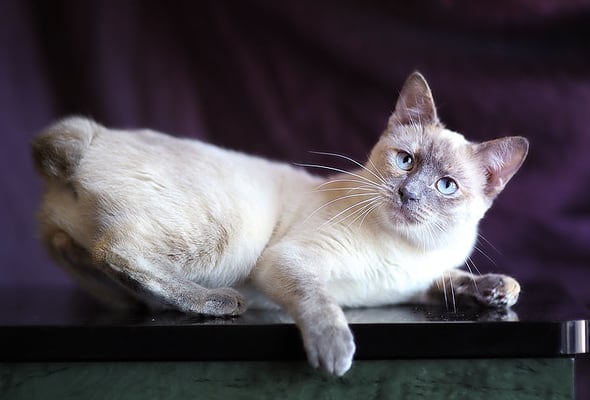
Average Lifespan: 15-18 years
Average Size: 8-10 pounds
Coat: short
Although formerly known as the Thai Bobtail, the breed has since been renamed after the Mekong river, a major river in Thailand, which is the cat’s true country of origin. Despite having roots in Thailand, the Mekong Bobtail was formalized and bred extensively in Russia after several individuals were gifted from the King of Siam to the Russian Emperor.
The breed possesses a striking and unique appearance, in part due to its bobbed tail, but also owing to its large blue eyes and pale fur. Incredibly rare and hard to come by even in Russian and Thailand, the breed is nearly impossible to find outside of these two countries.

